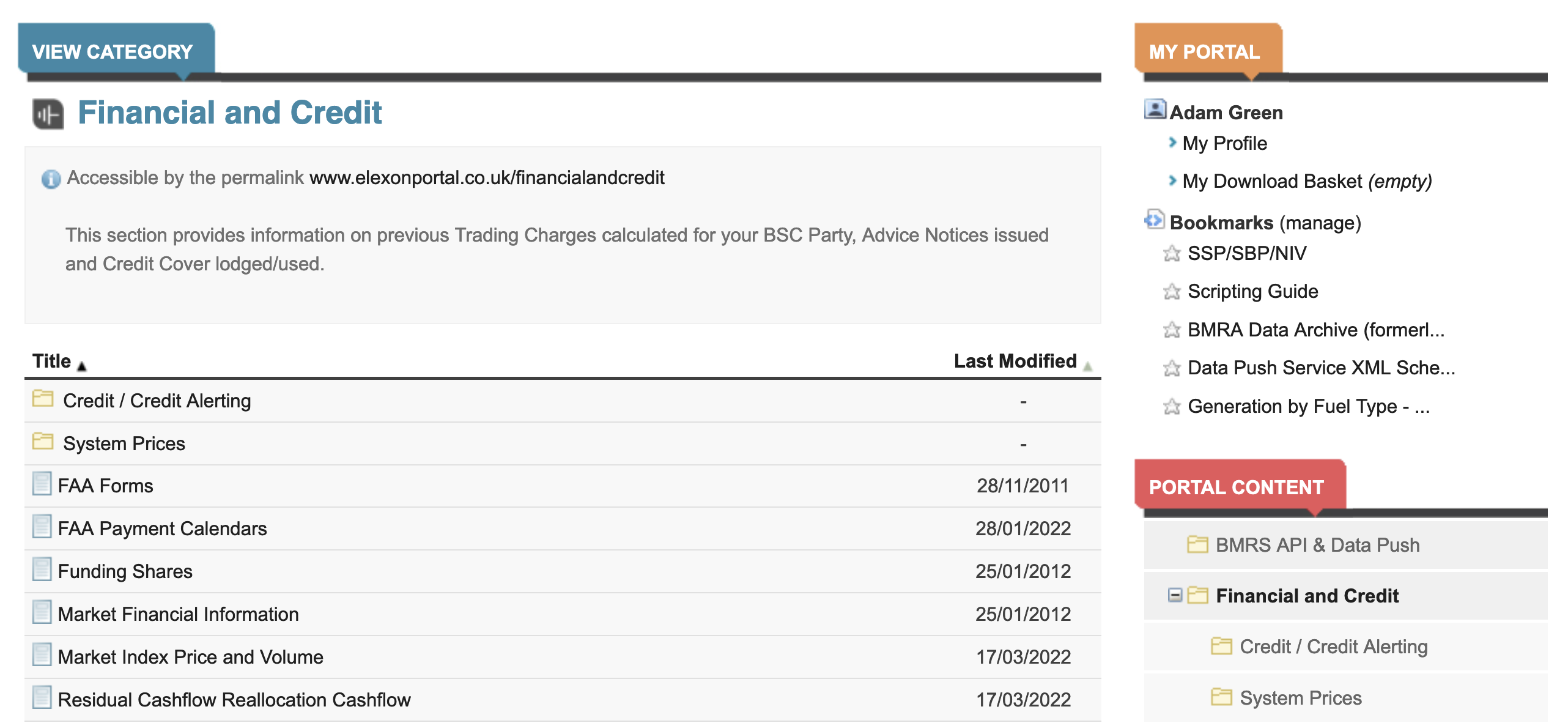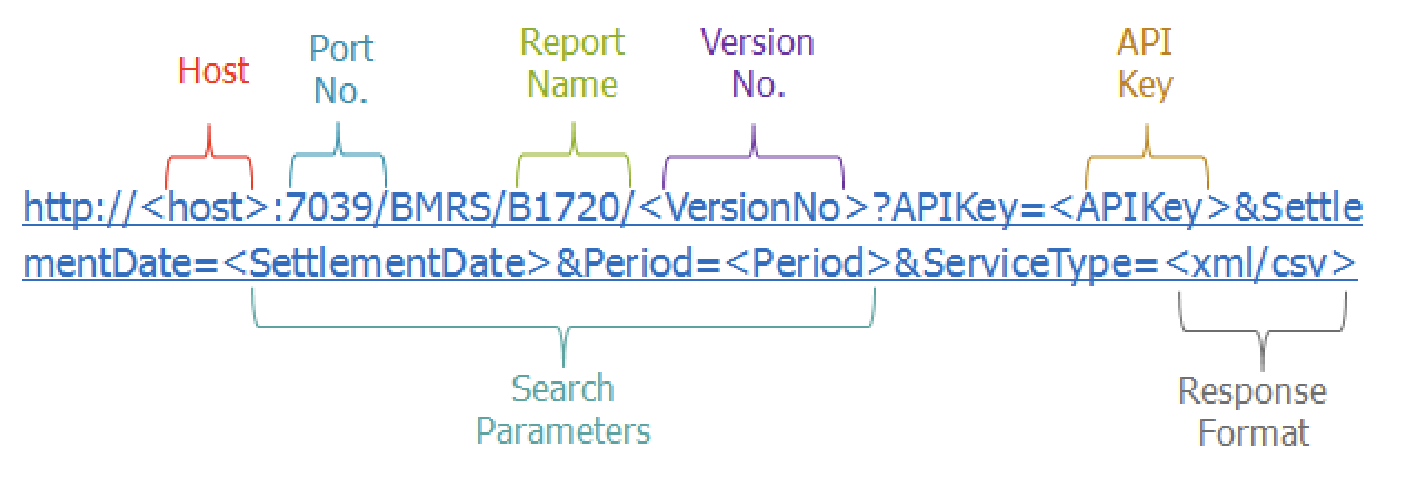Downloading, cleaning & joining UK electricity grid data with pandas, requests and pydantic.
This post demonstrates how to use Python to download UK electricity data using the Elexon API - specifically data for the imbalance price - both the imbalance prices and imbalance volumes.
In this post we will use the Python packages pandas for data processing, requests making HTTP requests and pydantic for structuring our data.
This work is inspired by Patrick Avis - the credit for this work will always be with Patrick!
Elexon provides generation, volume and price data for the UK electricity grid through the Balancing Mechanism Reporting Service (BMRS) - the BRMS can best thought of as a dataset.
The Elexon API guide provides detail on the data available through the BRMS. In this post we will be working with reports B1770 for imbalance prices and B1780 for the imbalance volumes.
The BRMS data is available through the Elexon Portal (through your web browser) or the Elexon API (to access data programmatically). Both require a free Elexon account.
You will need to be logged in to your Elexon account to use the portal, or else you will not see the data:

You will also need to create an Elexon account to use the API, as you need an API key (called a scripting key by Elexon) which you can find in the profile section of your Elexon account.
You can install the Python packages needed to run the Python program with:
$ pip install pandas pydantic requestsThe core logic of our program is below (without the required imports):
url = f"https://api.bmreports.com/BMRS/{report}/v1?APIKey={api_key}&Period=*&SettlementDate={date}&ServiceType={service_type}"
res = requests.get(url)
(Path.cwd() / "data.csv").write_text(res.text)
data = pd.read_csv("./data.csv", skiprows=4)The full program we develop is given at the end of the post.
Let’s start by requesting data from the Elexon API. We do this by making a HTTP request to a URL.
The Elexon API documentation specifies how we need to format our URL:

We will need to specify a few things to get the data we want: the report name (like B1770), our API key, the settlement date (like 2020-01-01) and the data format we want back (either XML or CSV).
The API key (which you can get through the Elexon portal) is a secret - it will not end up as part of our codebase.
One way to manage secrets is to create a file secret.py, which we can import from in other Python scripts:
# secret.py
api_key = "your-api-key-here"Very important that this file secret.py does not end up in your source control (commonly Git) - this file should be added to your .gitignore or equivalent. If secrets are in your source control, you are going to have a bad time.
In production environments these secrets are often managed at build/deploy time - where the secret is injected into the environment as environment variables.
Before we create our URL in as a string Python, we will define a pydantic type called ElexonRequest, to organize the data we need in the URL:
import datetime
import pydantic
from secret import api_key
class ElexonRequest(pydantic.BaseModel):
report: str
date: datetime.date
api_key: pydantic.SecretStr = pydantic.SecretStr(api_key)
service_type: str = "csv"
req = ElexonRequest(report="B1770", date="2020-01-01")
# report='B1770' api_key=SecretStr('**********') date=datetime.date(2020, 1, 1) service_type='csv'We can access data using the attribute (.) syntax:
print(req.report, req.date, req.service_type)
# B1770 2020-01-01 csvNow we have the data we need for a request, we can create our URL using a Python f-string:
url = f"https://api.bmreports.com/BMRS/{req.report}/v1?APIKey={req.api_key}&Period=*&SettlementDate={req.date.isoformat()}&ServiceType={req.service_type}"
# https://api.bmreports.com/BMRS/B1770/v1?APIKey=**********&Period=*&SettlementDate=2020-01-01&ServiceType=csvWhen we print the URL, the secret is hidden! This is because we used a SecretStr type for the API key. If we want to access the secret in api_key, we need to use api_key.get_secret_value().
Now we have our URL, we can use the Python library requests to call the Elexon API by making an HTTP request to the web server behind this URL - the same way your browser sends HTTP requests to a server to access a web page.
Along the way we check that the status code of the HTTP response is 200 (200 means everything is ok):
import requests
req = ElexonRequest(report="B1770", api_key=api_key, date="2020-01-01")
url = f"https://api.bmreports.com/BMRS/{req.report}/v1?APIKey={req.api_key.get_secret_value()}&Period=*&SettlementDate={req.date.isoformat()}&ServiceType={req.service_type}"
res = requests.get(url)
assert res.status_code == 200
print(res.text[:512])
# *
# *
# *Imbalance Prices Service For Balancing (B1770) Data
# *
# *DocumentID,DocumentRevNum,ActiveFlag,...Now all we need to do is save this raw data as a CSV file - making no changes to the data on the way.
We can use pathlib to dump this text to a file in a folder called data:
from pathlib import Path
fi = Path().cwd() / "data" / f"{req.report}-{req.date}.csv"
fi.parent.mkdir(exist_ok=True)
fi.write_text(res.text)We can use the shell command head to look at the first 7 lines of this file:
$ head -n 7 data/B1770-2020-01-01.csv
*
*
*Imbalance Prices Service For Balancing (B1770) Data
*
*DocumentID,DocumentRevNum,ActiveFlag,ProcessType,...We can then load this data back again using the Python library pandas - skipping the first 4 rows (they are not valid CSV data):
import pandas as pd
data = pd.read_csv("./data/B1770-2020-01-01.csv", skiprows=4)One final thing we may want to clean is to remove the final row (which contains <EOF> - end of file):
data = data.dropna(axis=0, subset=["SettlementDate"])This is current best practice in data engineering - saving the raw data and starting the next step by loading the data back again.
It may seem inefficient in terms of storage (it is) - but storage is cheap, and this system allows more flexible and independent data pipeline design.
In this section we will create two datasets - one for each report (B1770 & B1780).
Above we have created the code to send a single request to the Elexon API - let’s wrap it up inside a function:
import datetime
from pathlib import Path
import requests
import pandas as pd
import pydantic
from secret import api_key
class ElexonRequest(pydantic.BaseModel):
report: str
date: datetime.date
api_key: pydantic.SecretStr = pydantic.SecretStr(api_key)
service_type: str = "csv"
def send_elexon_request(req: ElexonRequest) -> pd.DataFrame:
url = f"https://api.bmreports.com/BMRS/{req.report}/v1?APIKey={req.api_key.get_secret_value()}&Period=*&SettlementDate={req.date.isoformat()}&ServiceType={req.service_type}"
res = requests.get(url)
assert res.status_code == 200
fi = Path().cwd() / "data" / f"{req.report}-{req.date}.csv"
fi.parent.mkdir(exist_ok=True)
fi.write_text(res.text)
data = pd.read_csv(fi, skiprows=4)
# B1770 has SettlementDate, B1780 has Settlement Date
data.columns = [d.replace(" ", "") for d in data.columns]
return data.dropna(axis=0, subset=["SettlementDate"])We can run our function using a single ElexonRequest:
data = send_elexon_request(ElexonRequest(report="B1770", date="2020-01-01"))But we want to make many requests - for two reports and many settlement dates.
Below we use a defaultdict to hold this data - iterating over both reports and dates to create two datasets:
from collections import defaultdict
dataset = defaultdict(list)
for report in ["B1770", "B1780"]:
for date in pd.date_range("2020-01-01", "2020-01-03", freq="D"):
data = send_elexon_request(ElexonRequest(report=report, date=date))
dataset[report].append(data)We can then take these lists of data and create a single dataframe for each report:
for report, data in dataset.items():
data = pd.concat(data, axis=0)
data.to_csv(f"./data/{report}-all.csv", index=False)
print(f"combined {len(data)} days for {report} into {data.shape}")
# combined 288 days for B1770 into (288, 15)
# combined 144 days for B1780 into (144, 15)At this stage we have two CSV files - one per report. Joining them together will require a bit more data cleaning.
There are two things we want to fix in data cleaning:
B1770: It currently has twice as many rows than B1780, due to stacking of the long & short imbalance pricesdatetime column: A column that combines the period and the date into a datetime for joiningNotice above how report B1770 has twice the amount of data as B1780? This is because the long and short imbalance prices are stacked on top of each other. This is not tidy data - we do not have one row per observation.
We can solve this problem using a pivot:
class ElexonReport(pydantic.BaseModel):
report: str
columns: list
rep = ElexonReport(
report="B1770",
columns=[
"SettlementDate",
"SettlementPeriod",
"ImbalancePriceAmount",
"PriceCategory",
],
)
data = pd.read_csv(f"./data/{rep.report}-all.csv")
data = (
data.pivot(
index=["SettlementDate", "SettlementPeriod"],
columns="PriceCategory",
values="ImbalancePriceAmount",
)
.sort_index()
.reset_index(drop=True)
)Now that we have a flat, tidy dataset, we can create a proper timestamp column to join on - by creating a date range:
data["datetime"] = pd.date_range(
start=data["SettlementDate"].min(),
periods=len(data),
freq="30T",
tz="Europe/London",
)
print(
data.loc[
:,
[
"SettlementDate",
"SettlementPeriod",
"datetime",
"Excess balance",
"Insufficient balance",
],
].iloc[:3, :]
)
# PriceCategory SettlementDate SettlementPeriod datetime Excess balance Insufficient balance
# 0 2020-01-01 1.0 2020-01-01 00:00:00+00:00 50.90000 50.90000
# 1 2020-01-01 2.0 2020-01-01 00:30:00+00:00 51.00000 51.00000
# 2 2020-01-01 3.0 2020-01-01 01:00:00+00:00 29.37006 29.37006Here is our full cleaning pipeline - from our CSV datasets (one per report) on disk to a single dataset:
reports = [
ElexonReport(
report="B1770",
columns=[
"SettlementDate",
"SettlementPeriod",
"ImbalancePriceAmount",
"PriceCategory",
],
),
ElexonReport(
report="B1780",
columns=[
"SettlementDate",
"SettlementPeriod",
"ImbalanceQuantity(MAW)",
"ImbalanceQuantityDirection",
],
),
]
dataset = {}
for rep in reports:
data = pd.read_csv(f"./data/{rep.report}-all.csv")
data = data.loc[:, rep.columns]
if rep.report == "B1770":
data = (
data.pivot(
index=["SettlementDate", "SettlementPeriod"],
columns="PriceCategory",
values="ImbalancePriceAmount",
)
.sort_index()
.reset_index()
)
data = data.sort_values(["SettlementDate", "SettlementPeriod"])
data["datetime"] = pd.date_range(
start=data["SettlementDate"].min(),
periods=len(data),
freq="30T",
tz="Europe/London",
)
data = data.set_index("datetime")
dataset[rep.report] = data
final = pd.concat(dataset.values(), axis=1)
final.to_csv("./data/final.csv")
final = final.loc[:, ~final.columns.duplicated()]And here is the entire pipeline - both the downloading of the data and the data cleaning pipeline:
from collections import defaultdict
import datetime
from pathlib import Path
import requests
import pandas as pd
import pydantic
from secret import api_key
class ElexonRequest(pydantic.BaseModel):
report: str
date: datetime.date
api_key: pydantic.SecretStr = pydantic.SecretStr(api_key)
service_type: str = "csv"
class ElexonReport(pydantic.BaseModel):
report: str
columns: list
def send_elexon_request(req: ElexonRequest) -> pd.DataFrame:
url = f"https://api.bmreports.com/BMRS/{req.report}/v1?APIKey={req.api_key.get_secret_value()}&Period=*&SettlementDate={req.date.isoformat()}&ServiceType={req.service_type}"
res = requests.get(url)
assert res.status_code == 200
fi = Path().cwd() / "data" / f"{req.report}-{req.date}.csv"
fi.parent.mkdir(exist_ok=True)
fi.write_text(res.text)
data = pd.read_csv(fi, skiprows=4)
# B1770 has SettlementDate, B1780 has Settlement Date
data.columns = [d.replace(" ", "") for d in data.columns]
return data.dropna(axis=0, subset=["SettlementDate"])
if __name__ == "__main__":
reports = [
ElexonReport(
report="B1770",
columns=[
"SettlementDate",
"SettlementPeriod",
"ImbalancePriceAmount",
"PriceCategory",
],
),
ElexonReport(
report="B1780",
columns=[
"SettlementDate",
"SettlementPeriod",
"ImbalanceQuantity(MAW)",
"ImbalanceQuantityDirection",
],
),
]
dataset = defaultdict(list)
for rep in reports:
for date in pd.date_range("2020-01-01", "2020-01-03", freq="D"):
dataset[rep.report].append(
send_elexon_request(ElexonRequest(report=rep.report, date=date))
)
for report, data in dataset.items():
data = pd.concat(data, axis=0)
data.to_csv(f"./data/{report}-all.csv")
print(f"combined {len(data)} days for {report} into {data.shape}")
dataset = {}
for rep in reports:
data = pd.read_csv(f"./data/{rep.report}-all.csv").loc[:, rep.columns]
if rep.report == "B1770":
data = (
data.pivot(
index=["SettlementDate", "SettlementPeriod"],
columns="PriceCategory",
values="ImbalancePriceAmount",
)
.sort_index()
.reset_index()
)
data = data.sort_values(["SettlementDate", "SettlementPeriod"])
data["datetime"] = pd.date_range(
start=data["SettlementDate"].min(),
periods=len(data),
freq="30T",
tz="Europe/London",
)
dataset[rep.report] = data.set_index("datetime")
final = pd.concat(dataset.values(), axis=1)
final = final.loc[:, ~final.columns.duplicated()]
final.to_csv("./data/final.csv")This post demonstrated how to:
requests with proper API key management using pydantic.SecretStrB1770) and volumes (B1780)pandas to pivot stacked data and create proper datetime indicespydantic, and creating modular, reusable functionsThanks for reading!